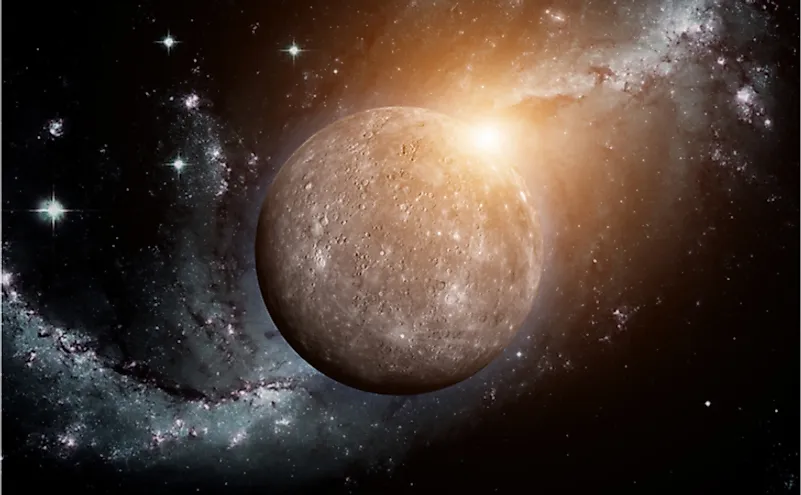10 Interesting Facts About Mercury

Mercury is the closest planet to the Sun and the smallest since Pluto was downgraded to a dwarf planet. It is also one of five planets visible by the naked eye, along with Saturn, Jupiter, Mars, and Venus. Despite its proximity to Earth, Mercury is among the least explored planets due to its proximity to the Sun. Nevertheless, researchers do not expect life to exist on the planet due to its unconducive environment.
Longer Day Than Year
It takes Mercury 176 Earth days to complete a rotation around its axis and 88 days to complete a revolution around the Sun, meaning that a day is longer than its year. Mercury and the Sun are nearly in a tidal lock, which has slowed the planet's rotation. Additionally, Mercury has the greatest orbital eccentricity, ranging from 29 million mi to 43 million mi.
Mercury’s Unique Orbit
Mercury revolves around the Sun at 112,000 mph, which is the fastest of all planets. Its orbit is immensely elliptical, as its distance from the Sun varies between 29 million mi and 43 million mi. The elliptical orbit also influences its visibility from Earth, as it can move between clear visibility or not be visible at all.
Difficult to Spot in the Sky
Mercury plays peekaboo with the Sun, as the planet rises and sets close to when the Sun does, which can make it challenging to see it in the sky. Ironically, the planet's existence was documented by ancient astronomers before the discovery of Venus and Mars. Current astronomers believe that the darker skies of the past made it possible for ancient astronomers to see Mercury.
Mercury Has No Rings or Moons
Mercury and Venus are the only two planets in the Solar System without either a moon or ring. Astronomers believe that in the past, both planets had moons, but that the Sun’s immense gravity pulled them away. Moons offer a better understanding of the formation of planets, and the lack of a moon leaves certain questions unanswered.
Second Hottest Planet
Mercury may be the closest planet to the Sun, but it is not as hot as Venus. Mercury has a light atmosphere that allows heat to escape, unlike Venus, which has a dense atmosphere that traps the heat. The side of Mercury that faces the Sun experiences temperatures of approximately 427 °C, while the alternate side can be as cold as -173 °C. Venus has an average temperature of 427 °C, as its dense atmosphere circulates heat evenly throughout the planet.
Molten Core
Recent studies show that Mercury indeed has a molten core, which is contrary to the solid iron core theory proposed throughout the 20th and early 21st centuries. The cores of smaller planets cool and solidify rapidly, but extensive research concludes that this is not the case for Mercury. Researchers believe that the core is made up of lighter materials that have lower melting points, such as sulfur.
Mercury Has Organic Material and Water Ice
Surprisingly, given its proximity to the hot Sun, Mercury contains water ice. However, this ice is located within permanently shadowed craters that do not receive sunlight throughout the year. Organic materials, which are the building blocks of life, have also been discovered, but the harsh conditions on Mercury cannot support life as it exists on Earth. The concentration of sulfur on Mercury is unlike any other planet in the Solar System.
The Most Cratered Planet
While other planets "self-heal" after collisions with comets and asteroids, Mercury does not, which has led to numerous craters on the planet's surface. Most are small craters, while a few are more than 50 mi wide. The largest crater is the Caloris Basin, which has a diameter of 963 mi.
Two Probes Have Visited Mercury
It is challenging to travel between Earth and Mercury not only because the closest distance between the two planets is over 48 million mi, but also due to the immense temperature from the Sun. Only two probes have reached Mercury: NASA's Mariner 10in 1974-75 and NASA's MESSENGER in 2004. In 2018, the European Space Agency (ESA) and the Japanese Aerospace Exploration Agency (JAXA) launched the joint BepiColombomission that is expected to reach the orbit of Mercury in December 2025.
Changing Atmosphere
Mercury has a fragile atmosphere known as an exosphere. It is unable to retain heat, which is why the dark side of the planet is frigid. Research shows that the concentration of magnesium, sodium, and calcium in Mercury’s atmosphere fluctuates depending on its distance from the Sun. Although there is no conclusive evidence regarding why this occurs, astronomers link it to solar radiation pressure.











